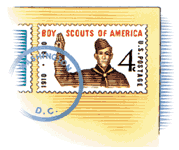![]() October 2000
October 2000

The letter in the May-June issue from Scouter Gordon Graham mentioned that one of his troop's favorite camp recipes was a dish called "Coca-Cola Chicken."
I would like to introduce some variety into our Scouts' cooking when they are camping. Is it possible to obtain this recipe?
Tina Potenberg
Columbus, Wis.
Gordon Graham, assistant Scoutmaster of Troop 2, Pellston, Mich., says the recipe that's a favorite with his Scouts is a modification of one originally found in a Coca-Cola recipe book. Below is the version Troop 2 enjoys:
Gordon Graham's Coca-Cola Chicken
In a Dutch oven, sprinkle onion flakes on six to eight chicken quarters. Add 6 oz. Coca-Cola and 1 cup catsup. Cook for 75 minutes. (If desired, add carrots with 45 minutes' cooking time remaining, and/or potatoes with 30 minutes left.)
The picture on page 34 with the article "Quality Time" in the May-June issue shows Scouts shooting what appear to be wooden arrows with compound bows.
The high amount of stored energy in a compound bow could cause a wooden arrow to blow up upon release ... causing severe injury to the shooter or the other Scouts on the firing line. As a bowhunter safety instructor, I would recommend that wooden arrows not be used with a compound bow.
John Walsh
Vice Chairman, Twin Lakes District
Bay Lakes Council
Oshkosh, Wis.
Thank you for the safety alert. Your advice is seconded by Lloyd Brown Jr., youth archery program director of the Easton Sports Development Foundation, an organization which assisted in preparing the Archery Merit Badge Pamphlet; he agrees: "Wooden arrows are not recommended for compound bows and can be dangerous if so used."
In thinking about the key transitions in my life, I find myself focusing on a single progression that has meant so much to my development as a person...the transition from Cub Scouts to Boy Scouts.
This move had such an impact on me as an 11-year-old boy that I remain active in Scouting more than 30 years later.
As a boy, I wanted to camp and hike; the fact that Scouting might provide lasting benefits was lost on me. I had freedoms (and responsibilities) I had never experienced. I was sleeping in tents, building campfires, using a knife and ax to prepare food and build camp gear. I couldn't care less that Scouting was character-building—I was just having fun!
I spent more than 350 days and nights camping, in 21 states and three countries, backpacked more than 1,000 miles, went to Philmont Scout Ranch in New Mexico, and became an Eagle Scout. At age 18 and ready to leave Scouting, I started to realize the values it had imparted upon me—and I decided to make the transition to Scout leader, a decision that has lasted 25 years.
However, I could have missed out on all this "positive passion" except for the influence of people like my dad, who told me to give Scouting a chance. Mom and Dad knew I wanted activities that were exciting, challenging, and fun, and not necessarily educational or moral in structure. But they saw the value of Scouting, and did everything to keep me involved. ...
... Scouting continues to be a great program, but while some Cub Scout packs thrive, Scout troops in the same communities struggle to connect with boys and parents. That's a reason I urge everyone to give Scouting a good look and then decide if it has value. I'm confident that most every boy will discover the same lifelong values that I did.
John W. Kennedy
Executive Board Member
Patriots' Path Council
Madison, N.J.
Thank you for the article on horseback riding in your May-June 2000 issue. It helped me [make] my decision on which program activity to take during our summer camp trip to Tennessee.
I am 12 years old and had never been around horses very much, so the article ... gave me tips on what to do while I was horseback riding. It helped me to be more relaxed in the saddle than I would have been otherwise.
Jonathan Le June
Star Scout, Troop 156
Lafayette, La.
The May-June article "Wilderness Horse Sense" says that "riders will usually ask overtaken hikers to stop walking and wait alongside the uphill side of the trail as the horse string passes."
The Boy Scout Handbook on page 215 says that riders "will usually ask you to stop a few paces downhill from the trail and stand quietly while the animals pass." ... [and] I was always told that if you were uphill and happen to stumble, you could fall into the animals and spook them.
C. Hedinger
Former Scoutmaster, Troop 74
Manhattan, Kan.
The uphill side option for hikers was included in the original text for the May-June article, but the following sentences were left out of the final version: Some wrangers may ask [hikers] to take the uphill side, some the downhill. If your trail has a steep downhill incline, you'll want to keep to the uphill side. You wouldn't want to tumble down the slope, or have a horse and rider do so with you underneath. Whether uphill or down, stand well off the trail, keeping quiet so as not to alarm the animals. Do not pet or startle the horses in any way.
Copyright © 2000 by the Boy Scouts of America. All rights thereunder reserved; anything appearing in Scouting magazine or on its Web site may not be reprinted either wholly or in part without written permission. Because of freedom given authors, opinions may not reflect official concurrence.
| The Boy Scouts of America | http://www.scouting.org |